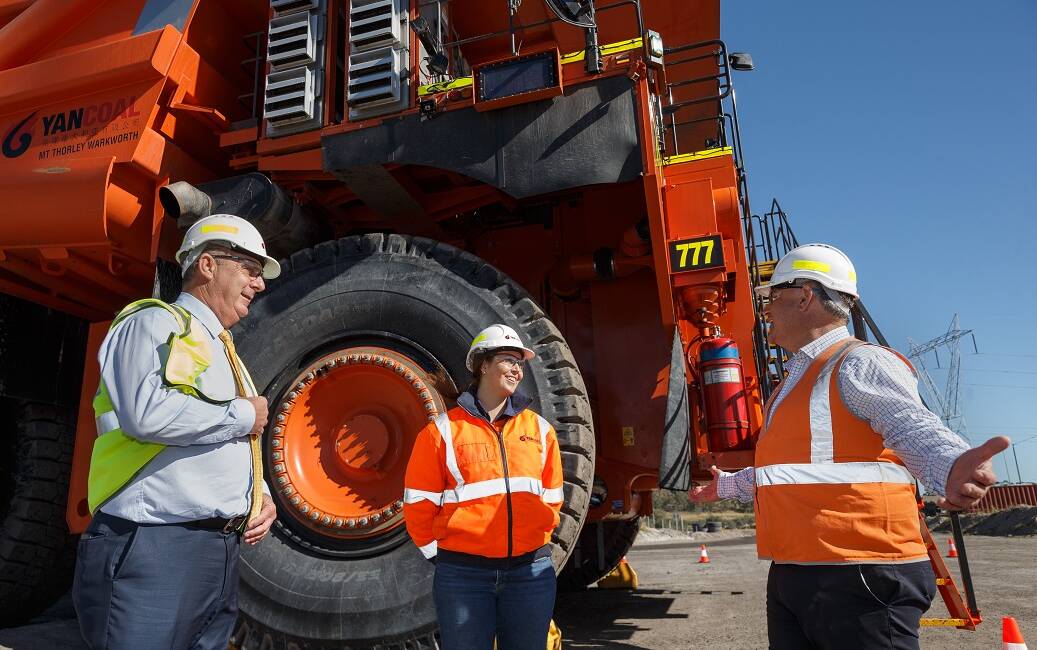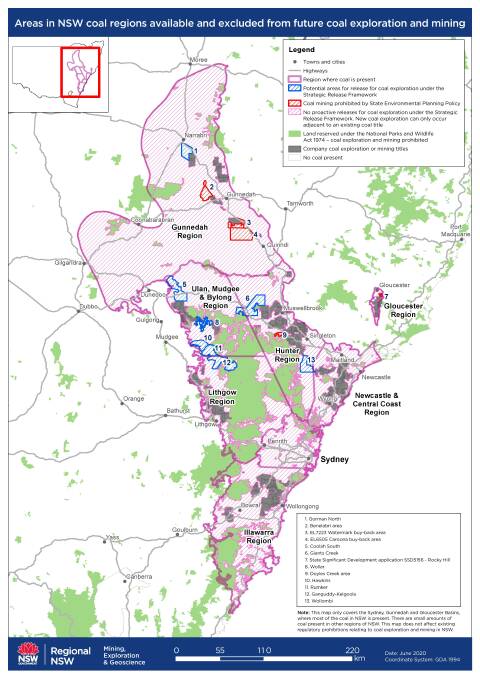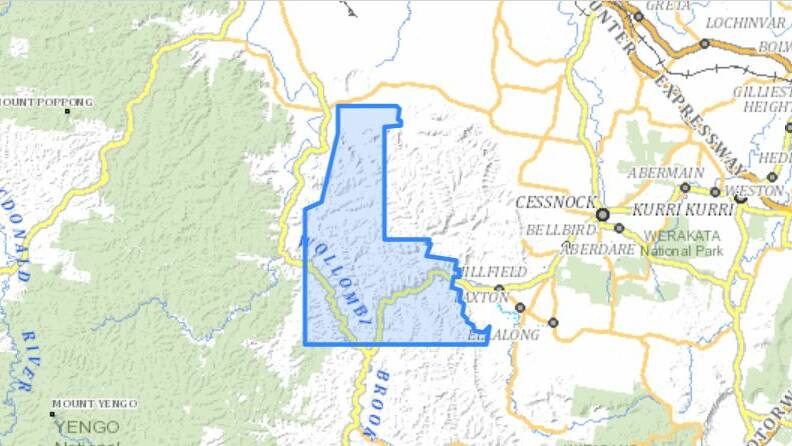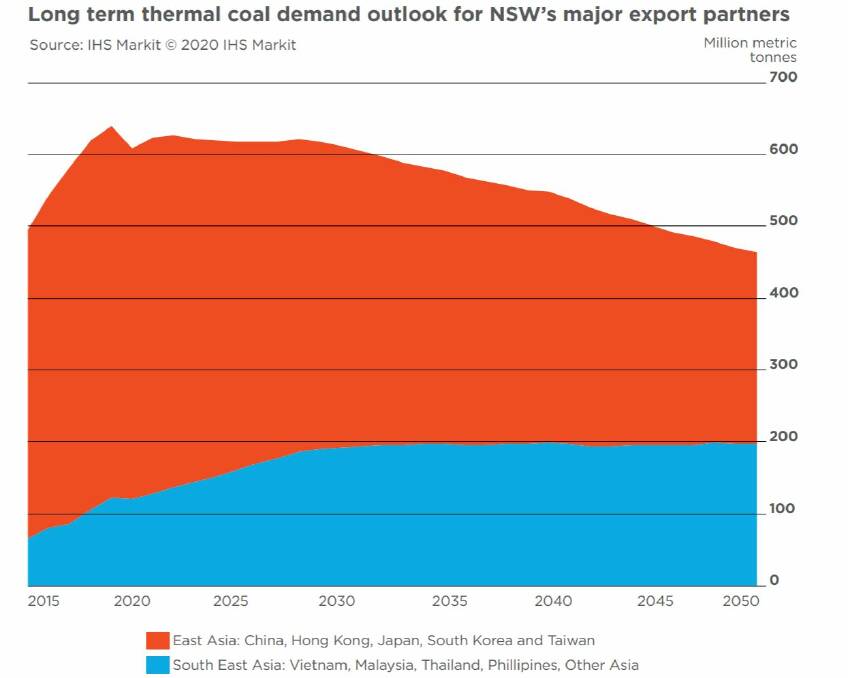
THE state government's new coalmining policy says there is no point in reducing coal exports for environmental reasons, and it opens up eight substantial areas for exploration in the Hunter and adjacent areas, including 178 square kilometres of state forest between historic Wollombi and Broke.
Subscribe now for unlimited access.
$0/
(min cost $0)
or signup to continue reading
Deputy Premier John Barilaro formally unveiled the state's Strategic Statement on Coal Exploration and Mining at Yancoal's Mount Thorley/Warkworth open-cut near Singleton yesterday morning.
Flanked by Upper Hunter MP Michael Johnsen and the NSW Minerals Council chief executive Stephen Galilee, Mr Barilaro said he had promised at last year's state election to make NSW the "number one destination for mining investment", and this policy continued that "vision and bold approach".
A map of coal-bearing regions released with the policy earmarked five exploration areas that prohibited coal mining by legislation.
Mr Barilaro acknowledged that the exploration licences for these areas had already been relinquished, and that the government had not extended any mining bans, including in the area southwest of Sydney, where underground mines were operating controversially under the Warragamba Dam catchment area.

The map includes eight exploration areas Mr Barilaro said were part of its "fast track" approach for mining approvals, including the major Giants Creek area, north of Muswellbrook, Gorman North, at Narrabri, and five areas in the Ulan, Bylong and Mudgee regions, as well as Wollombi.
The map says that "no proactive releases for coal exploration" can occur across the rest of the potentially available exploration area from the Illawarra north to the Hunter, Gloucester and Gunnedah regions.
But a proviso allows exploration "adjacent to an existing coal title", meaning operating mines can explore for potential expansion into these areas.
Mr Galilee said the industry welcomed the commitment to a "streamlined strategic release process and the potential release of new areas for exploration".
Environmental groups were less impressed, although Lock The Gate Alliance and the Institute of Energy Economics and Financial analysis (IEEFA) said the statement was an important shift, in that it at least acknowledged that demand for thermal coal was in decline.
Lock The Gate spokesperson Georgina Woods said the statement foreshadowed new measures to strengthen mine rehabilitation requirements, improve protections for air quality and water resources, and to work with coal mining regions to diversify their economies.
Ms Woods said that the report lacked substance because it failed to provide specific policies or a timeline for these measures, even while new and expanding coal mining projects were under consideration by the government.
She said the decision to promote the Wollombi exploration area (authorisation 263), which began just north of the historic township, was wrong.

"Wollombi is a premier tourist destination, and this exploration area stretches from the edge of the town north through state forest to the southern of Bulga open cut at Broke," Ms Woods said.
"It goes to show the government doesn't have a strategic idea about how the region will respond to coal exploration in an area dedicated to tourism and nature. It is really short-sighted.
"Even an underground mine would have substantial impact, with surface infrastructure and a train line to get the coal out, and that's without the subsidence and water issues, especially that Wollombi Brook, which runs through it, is already compromised by mining."
The new strategy notes that 80 per cent of the Hunter's coal is thermal coal burned in power stations while the other 20 per cent is metallurgical coal for steelmaking.
One graph published with the strategy predicts a decline of about 25 per cent by 2050 in thermal coal demand for Newcastle's major coal export customers, while overall global demand is predicted to fall by a much smaller 10 per cent.
"Ending or reducing NSW thermal coal exports while there is still strong long-term global demand would likely have little or no impact on global carbon emissions," the strategy says.
"Most coal consumers would be likely to source their coal from elsewhere, and much of this coal would be lower quality compared to NSW coal. Reducing demand for thermal coal in line with the Paris Agreement by progressively replacing coal-fired electricity with cleaner energy sources, as has been seen in Europe, will be more effective in reducing global emissions than reducing NSW coal supplies."
The strategy says NSW exports account for "only around 3 per cent" of global coal consumption and that 80 per cent of the state's electricity still comes from coal. Globally, more than a third of the world's electricity came from coal.
It says the industry provides 22,000 direct jobs and 89,000 indirect jobs.
IEEFA's Tim Buckley said the government had under-estimated the rate of coal decline.
Beyond Zero Emissions spokesperson Samantha Mella said the government should invest in "emerging opportunities" instead of backing "sunset industries like coal". She said the Hunter could "still export energy, just in different ways".

While you're with us, did you know the Newcastle Herald offers breaking news alerts, daily email newsletters and more? Keep up to date with all the local news - sign up here
IN THE NEWS:
- Police body cam footage released after horrifying arrest as bystanders berate and shout abuse at police at Hamilton South
- Stockton may need sand from offshore federal waters says Nelmes
- Alleged Newcastle ship stowaway: man found in bulk carrier's air conditioning charged with breach of bail
- Can Knights and Jets work together in winter?
- Federal police charge Birmingham Gardens man with facilitating entry of five or more unlawful


